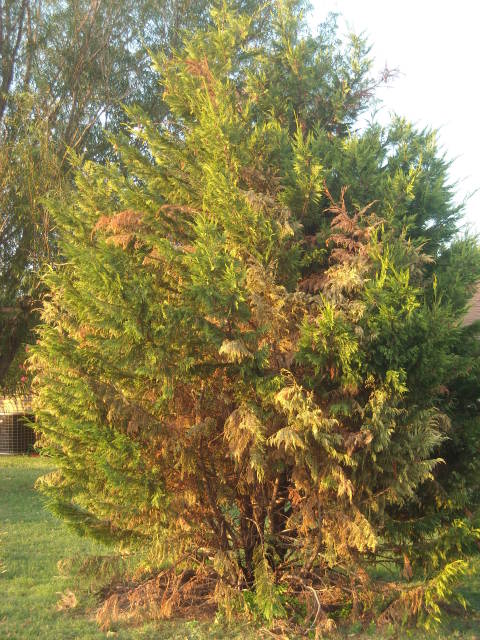Question Evergreen Tree
Evergreen Tree
QUESTION: I have an evergreen that has been doing just fine for about 10 years. I recently noticed that a lot of the branches are turning yellor then brown and dying. It is more predominant on the west side of the tree as well. I looked for bugs and spiders (webs) and have not noticed any unusual infestation. I did notice some sap seeping off the trunk of the tree so I am not sure if that has anything to with bugs or not. It is a very special tree so any help would be much appreciated. I have watered regularly and the only other thing that I had to do was to spray it for bagworms about 3 mos ago....the bagworms died. Please help! I have attached some pictures for you.
Thank you
ANSWER: Erica:
This tree looks like a Leyland Cypress. This tree is quite susceptible to a branch disease called Branch Canker. Check this website below for a description and management. It is a pdf file, so you will need a free program (Adobe Reader)on your computer to view and read. If you are unsuccessful, let me know. http://www.uaex.edu/Other_Areas/publications/PDF/FSA-7536.pdf
Also, be sure to maintain good soil moisture since trees are more susceptible if they remain thirsty for a while. Also, check the base of the tree for any kind of bark injury from string trimmers/lawnmowers etc.
Take a look at this website/publication mentioned above and let me know if you have any additional questions.
Regards
Steve
---------- FOLLOW-UP ----------
QUESTION: Hi Steve!
Thank you for the response. I will check the article out and see if I can solve the problem from there.
There was some bark damage but not from a lawn mower or weed eater, it just started to fall off. I spray painted it to keep bugs and disease out of the open flesh. Would this disease cause the bark towards the bottom of the tree to fall off?
Thanks again for all your help! It means the world to me!
ANSWER: Erica:
Good Morning- Hello Again.
This Branch Canker disease mentioned in my earlier reply affects the branches and upper portions of the tree. I am not aware of it being an issue with the base of the tree. If no equipment could be the cause, then maybe an animal may have chewed on the trunk. If the injury is significant enough, then the tree could show the result as shown in your photo. Your photo looks more uniform than the branch canker symptoms do. Does the wound look fresh? Does it look like teeth marks are there? May be difficult determining the cause of the wound. If the wound is severe enough then saving the tree may ultimately be difficult, since a wound interrupts food/water flow. The best you could do is adequate waterings to avoid drought stress and keep your fingers crossed.
If this is a Leyland Cypress, these are fast growers in the right spot. They can get 40-50 ft tall. They are common here- but get this disease too. These trees are often planted in a row as a screen. As a little insurance, you might consider pruning out the dead portions, unfortunately this may adversely affect the overall shape.
Hope this helps.
Steve
---------- FOLLOW-UP ----------
QUESTION: Well, I do have three dogs but I did not notice any teeth marks. However it is one of their favorite trees to lay under bcs of it's size but I don't think they would have been able to get that close to it since the branches lay so low. I figured this might have been the problem since it was mostly on the west side of the tree and that is the side I found the damaged trunk on.
Will it re-grow it's outer bark or is there something that I could put over it to seal it up a little better.
I will keep it watered and trim the branches again and keep my fingers crossed :)
Thanks again
AnswerErica:
Those things that you mentioned are all good. I have not heard of dogs doing this type of damage, but I suppose it is possible. If the tree is growing vigorously, it can "heal" itself to some extent, that is why it is a good idea to encourage vigorous growth so as to increase its' chances of repair. If you do replace it with another tree, you might consider placing a piece of hardware cloth near the base to prevent any "visitors" from damaging the bark. These wounds can also provide entry points for disease organisms.
Steve






